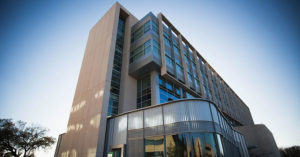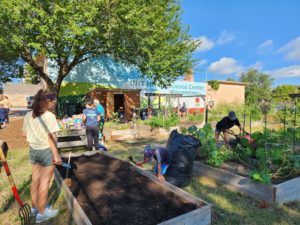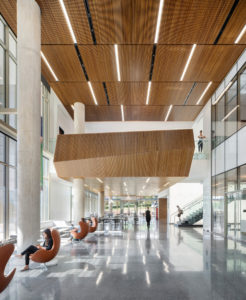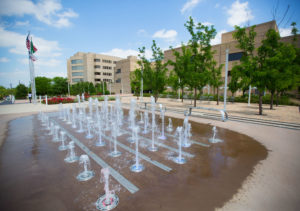Built Environment
What began in a bowling alley over 50 years ago now extends across 33-acres in Fort Worth’s Cultural District. We have undergone tremendous growth since 1970 with more plans in place to grow in the future.
Green building design and construction promotes environmental, economic, and social benefits to our campus and community. The university is committing to build all new campus buildings with at least a Leadership in Energy and Environmental Design (LEED) Silver certification, and we aim to incorporate sustainable features in any new construction project. See some of our highlights below.
 Medical Education & Training (MET) Building
Medical Education & Training (MET) Building
The MET, located at 1000 Montgomery Street, was build in 2010 and earned the UNT System its first LEED Gold certification by being designed and built using methods to improve energy and water efficiency, reduction of CO2 emissions, improved indoor air quality, and waste diversion. LEED is an internationally recognized program developed by the U.S. Green Building Council to provide third-party verification that a building was designed and built using practical and measurable green building design, construction, and operational methods.
Sustainable Features of the MET:
- 92.4% of the previous building’s construction was recycled
- Over 20% of the MET’s construction materials contained recycled matter and/or was extracted, processed, and manufactured within 500 miles of the its location
- Indoor air quality was considered in the choice of the building materials and ventilation systems
- The fire suppression system does not contain ozone-depleting substances
- Approximately 250,000 gallons of potable water are saved each year
- An estimated $55,000 in energy costs are saved every year
 HSC Community Garden
HSC Community Garden
The HSC Community Garden was established in 2014 by HSC Sustainability and is located on the north side of campus. It includes thirty five 12’x4′ garden beds which are rented out to students, employees, or people in the community. We donate up to 25% of each plot’s yield through organized donations to food pantries including the HSC Student Food Pantry. Over 2,000 lbs. of fresh produce has been donated since 2014.
We have on-site composting and have diverted 12,510 lbs. of food waste and coffee grounds through community partnerships.
Library Courtyard
The Library Courtyard is approximately 2 acres of functional green space in the center of campus and is used by HSC students and personnel and the larger community. The courtyard improves the image of the campus, generates more pedestrian friendly spaces, creates meeting and social spaces, and reduces the impervious surface area on campus.
Interdisciplinary Research & Education Building (IREB)
The IREB, located at 3430 Camp Bowie, opened in 2018 and is LEED Gold Certified. LEED is an internationally recognized program developed by the U.S. Green Building Council to provide third-party verification that a building was designed and built using practical and measurable green building design, construction, and operational methods.
 Sustainable Features of the IREB:
Sustainable Features of the IREB:
- Diverted 75.65% of the construction waste from the landfill
- 39.04% reduction of potable water use
- Energy cost savings of 19.1%
- 33.95% recycled content used in the building materials
Campus Master Plan
In the Fall of 2017, HSC embarked on a comprehensive campus master plan to craft a shared vision for the future that seeks to align the purpose, people and place of the institution. This alignment will be translated into physical construction and renovation projects in the future.
The campus master plan will pair aspirational goals with physical implementation to provide a roadmap for the future physical renewal and development of campus. It considers the potential needs for future academic, research, clinical and supporting spaces necessary to properly support this renewal and growth while creating a distinct and positive campus environment.


Social media